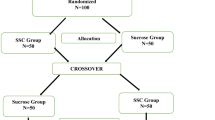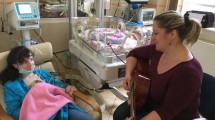Abstract
OBJECTIVE:
Skin-to-skin contact (kangarooing) is regarded as an important method to improve intensive care in premature infants. There is still demand for investigations of its impact on physiological parameters.
STUDY DESIGN:
We examined 53 preterm infants of <1800 gm in a prospective, pretest-test-posttest design study during incubator care (60 minutes), skin-to-skin contact (90 minutes), and incubator care again (90 minutes). Heart rate, respiratory rate, oxygen saturation (SaO2), transcutaneous pO2 (tcpO2), transcutaneous pCO2, rectal temperature, and fraction of inspired oxygen were measured.
RESULTS:
The heart rate increased during skin-to-skin contact by 5 beats per minute (p < 0.001), the respiratory rate dropped by 5/minute (p < 0.01), the SaO2 improved by 0.4% (p < 0.05) accompanied by an increase of tcpO2 of 4.8 mm Hg (p < 0.001), the tcpCO2 dropped by 1.2 mm Hg (p < 0.001), and the rectal temperature increased by 0.3 ° C (p < 0.001). Analyzing three groups separately by postnatal weight, we observed the smallest increase in heart rate and the highest decrease in respiratory rate in infants of <1000 gm (p < 0.001). The increase in SaO2 and in the tcpO2 doubles in infants of <1000 gm compared with infants of >1000 gm (p < 0.001). All changes were independent of postnatal age.
CONCLUSION: During skin-to-skin contact, preterm infants not only remain clinically stable but also show a more efficient gas exchange. Although the patient is removed (transferred) from the incubator, there is no risk of hypothermia even in infants of <1000 gm.
This is a preview of subscription content, access via your institution
Access options
Subscribe to this journal
Receive 12 print issues and online access
$259.00 per year
only $21.58 per issue
Buy this article
- Purchase on Springer Link
- Instant access to full article PDF
Prices may be subject to local taxes which are calculated during checkout
Similar content being viewed by others
Author information
Authors and Affiliations
Rights and permissions
About this article
Cite this article
Föhe, K., Kropf, S. & Avenarius, S. Skin-to-Skin Contact Improves Gas Exchange in Premature Infants. J Perinatol 20, 311–315 (2000). https://doi.org/10.1038/sj.jp.7200378
Published:
Issue Date:
DOI: https://doi.org/10.1038/sj.jp.7200378
This article is cited by
-
NICU sensory experiences associated with positive outcomes: an integrative review of evidence from 2015–2020
Journal of Perinatology (2023)
-
Enhancing sensory experiences for very preterm infants in the NICU: an integrative review
Journal of Perinatology (2017)
-
Les soins centrés sur l’enfant et sa famille et le modèle du couplet care scandinave : un modèle applicable à la France ?
Revue de médecine périnatale (2016)
-
Impact of kangaroo mother care on cerebral blood flow of preterm infants
Italian Journal of Pediatrics (2014)
-
Sensorialité de nouveau-né prématuré et environnement humain à l’hôpital
Revue de médecine périnatale (2011)



